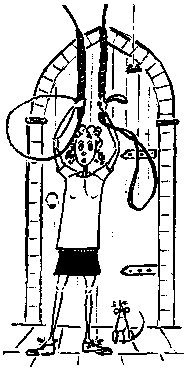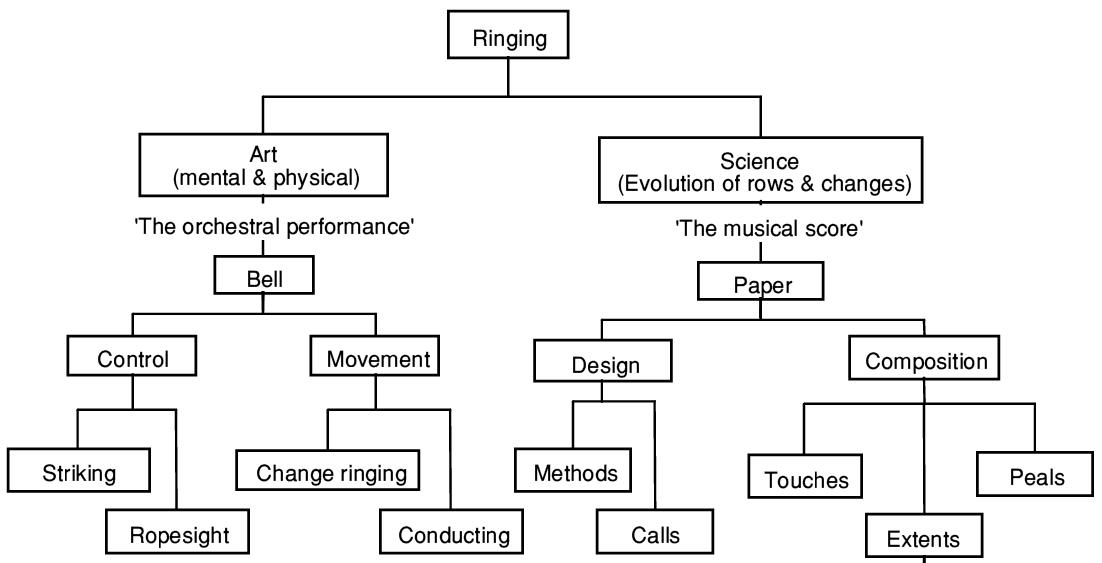 It is a misleading name. Most of us ring a bell with two hands. Two bell ringing might be a better title. One person has a rope in each hand.
It is a misleading name. Most of us ring a bell with two hands. Two bell ringing might be a better title. One person has a rope in each hand.The Tower Handbook
These rules date from the time before bells had stays. Overturning a bell meant letting it go too far over the balance, so that it could not be pulled back. Getting it back into ringing order meant the rope had to be re-threaded, and to do this the other bells would probably have to be lowered as well. No wonder the fine usually consisted of a large amount of ale.
In the eighteenth century ringing was a secular activity that only took place in churches because that was where the bells were. There was a lot of drinking and gambling associated with ringing, and as a result clergy did not want ringers to be in church on Sundays.
Historically, there has been the odd ring of seven or nine [16] but they have never been popular. When change ringing was evolving in the sixteenth and seventeenth centuries, many rings of bells were fives and most early method development was on five bells. Augmentation to six raised new possibilities. Beyond six increases tended to be to even numbers. The step to eight is a complete octave. Most people think Triples rung with a cover sounds more attractive than when rung on seven bells. Twelve bells makes some 'musical sense' since the treble is the dominant in the key of the ring. Arguing for ten in this way is more tenuous. Fourteen and sixteen definitely do not make 'musical sense', since two octaves starting with the tonic would give fifteen [17] bells. It is fairly widely accepted among change ringers on higher numbers that the rhythm is a lot easier to hear and ring on even numbers of bells [18].
That's a bit like asking mountaineers why they climb mountains. In many activities people like to set and achieve challenging goals as a way of measuring their prowess. In the early days of ringing, a 5040 on seven bells was a significant achievement both technically and physically. It still is for many ringers, who ring peals either occasionally or not at all. Those who ring peals frequently often claim that the quality of the ringing is superior to other ringing they take part in. The Central Council records all peals [19]. This makes peals an appropriate way of marking important local and national events.
Many people prefer ringing quarter peals to commemorate events. The shorter length is easier to fit in before a service. Quarter peals do not have the same status as peals. The Ringing World is not obliged to publish them.
'Tailors' is a corruption of 'tellers', tolled to announce the passing (or imminent passing) of a life. The blows are struck in threes, with a pause between each three. The convention was thrice one for a child, thrice two for a woman and thrice three for a man, hence 'nine tailors' signalled a man's death. After a longer pause further tolling counted out the years of the passing life, again in threes, with three for each year. The tellers counted the span of life much as tellers in a bank count out money. The expression was made famous as the title of the book The Nine Tailors by Dorothy Sayers, in which a murder mystery is constructed around a band of ringers in the Fens.
In the area around Verona, bells are hung for ringing full circle with rope and wheel, similar to the English style of hanging. The bells are much more heavily counter balanced which allows them to be rung high in slender towers.
They are not used to ring changes but instead ring specially composed tunes called concerti. Individual bells are struck as required by the tune. Each ringer strikes his bell once whenever the conductor (who does not ring) calls his number. They sometimes ring chords. This style of ringing needs a high degree of bell control to be able to ring the bell once and then hold it just over the balance (with no stay) until the next time it is called for. Around Bologna, the bells are also rung full circle, but without wheels. The rope wraps round the headstock and the bell itself, with further control provided by ringers standing very close to the bells and controlling them by hand.
People have the impression that it is well-struck and fast. The first is true, the second less so. The impression of speed is caused by the absence of a handstroke gap (ie cartwheel ringing). In a standard touch they raise the bells (rather quickly), ring a set touch of call changes, and lower the bells. The most common touch on six bells is 'sixty on thirds'. Thirds is another name for queens. Details of this touch are on the back end paper of The Ringing World Diary (for 1997). On eight bells, a simpler touch is usually used. The best bands in Devon take part in regular competitions throughout the summer.
 It is a misleading name. Most of us ring a bell with two hands. Two bell ringing might be a better title. One person has a rope in each hand.
It is a misleading name. Most of us ring a bell with two hands. Two bell ringing might be a better title. One person has a rope in each hand.
It requires considerable co-ordination for two reasons. The rope handling must be very tidy when catching the sally with a single hand containing the tail end. But the most difficult aspect is to prevent the way you control the two bells from getting mixed up. It is very easy to feel the first bell dropping but pull the second one instead. Rope length also seems to be more critical than with normal ringing (but it is harder to control it effectively when you only have a single hand for each rope).
Most music has (at least) five different characteristics: melody (changing notes), harmony (notes sounded together), timbre (different types of sound), rhythm (different length notes) and emphasis (loudness and softness). Only the first of these really applies to ringing. We shouldn't ring chords, we have a single type of instrument, the rhythm should be completely even and we cannot control the loudness of each blow. The physical constraints of ringing tower bells full circle make even conventional melodies impossible since no note can be quickly repeated. As a result there are strong constraints on what sequences are allowed.
But there are some similarities. Ringing composers care about 'music', ie obtaining rows, sequences or parts of rows that they consider sound more pleasing. Many of these would be judged musical by conventional musical theory, for example roll ups ending 468 (on eight bells) or 680 (on ten), are very popular and are instantly recognisable by a musician as the notes of a major triad.
Ringing bears most resemblance to 'minimalist' music, a form made popular during the late 20th century. It consists of simple note patterns repeated over and over again with gradual changes in the pattern. This is not an exact description of ringing, but it comes pretty close. There is also a musical term called 'hocketing' in which a group of people play a tune but different people play different notes. That sums up ringing fairly well.
It is generally assumed to be both with the theory more science-like and bell handling more art-like, but it might be more accurate to call it a 'craft'. The introduction to Part II of the Ringers Manual of Reference includes this diagram to help support the view of ringing as both an art and a science.

From 'Method Structure in Change Ringing (an Introduction to its Theory and Technology, Albert York-Bramble, College of Campanology, 1965.
Currently hosted on jaharrison.me.uk